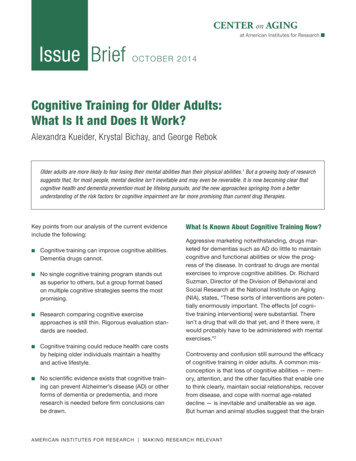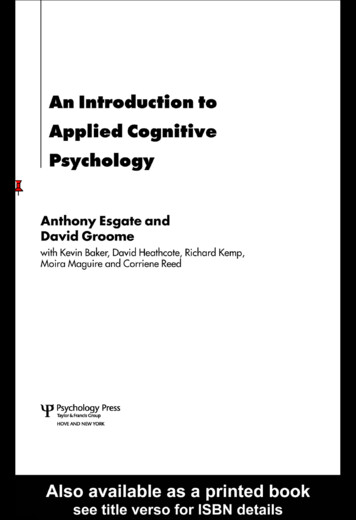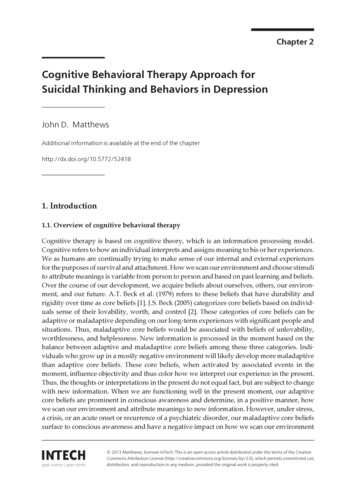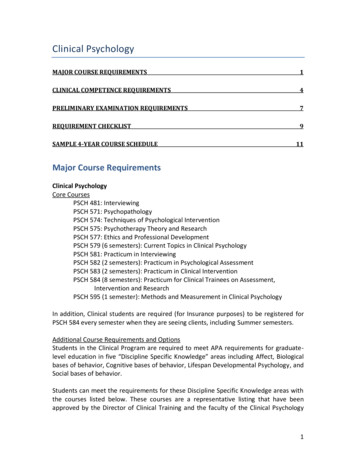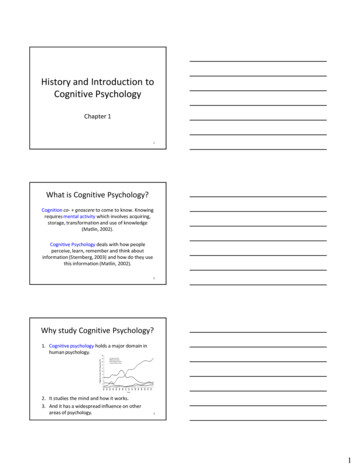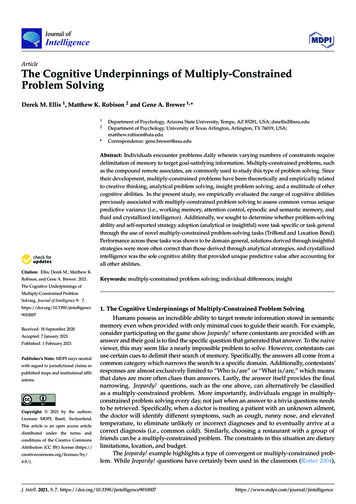
Transcription
Journal ofIntelligenceArticleThe Cognitive Underpinnings of Multiply-ConstrainedProblem SolvingDerek M. Ellis 1 , Matthew K. Robison 2 and Gene A. Brewer 1, *12* Department of Psychology, Arizona State University, Tempe, AZ 85281, USA; dmellis2@asu.eduDepartment of Psychology, University of Texas Arlington, Arlington, TX 76019, USA;matthew.robison@uta.eduCorrespondence: gene.brewer@asu.eduAbstract: Individuals encounter problems daily wherein varying numbers of constraints requiredelimitation of memory to target goal-satisfying information. Multiply-constrained problems, suchas the compound remote associates, are commonly used to study this type of problem solving. Sincetheir development, multiply-constrained problems have been theoretically and empirically relatedto creative thinking, analytical problem solving, insight problem solving, and a multitude of othercognitive abilities. In the present study, we empirically evaluated the range of cognitive abilitiespreviously associated with multiply-constrained problem solving to assess common versus uniquepredictive variance (i.e., working memory, attention control, episodic and semantic memory, andfluid and crystallized intelligence). Additionally, we sought to determine whether problem-solvingability and self-reported strategy adoption (analytical or insightful) were task specific or task generalthrough the use of novel multiply-constrained problem-solving tasks (TriBond and Location Bond).Performance across these tasks was shown to be domain general, solutions derived through insightfulstrategies were more often correct than those derived through analytical strategies, and crystallizedintelligence was the sole cognitive ability that provided unique predictive value after accounting forall other abilities.Citation: Ellis, Derek M., Matthew K.Robison, and Gene A. Brewer. 2021.Keywords: multiply-constrained problem solving; individual differences; insightThe Cognitive Underpinnings ofMultiply-Constrained ProblemSolving. Journal of Intelligence 9: ived: 18 September 2020Accepted: 7 January 2021Published: 1 February 2021Publisher’s Note: MDPI stays neutralwith regard to jurisdictional claims inpublished maps and institutional affiliations.Copyright: 2021 by the authors.Licensee MDPI, Basel, Switzerland.This article is an open access articledistributed under the terms andconditions of the Creative CommonsAttribution (CC BY) license (https://creativecommons.org/licenses/by/4.0/).1. The Cognitive Underpinnings of Multiply-Constrained Problem SolvingHumans possess an incredible ability to target remote information stored in semanticmemory even when provided with only minimal cues to guide their search. For example,consider participating on the game show Jeopardy! where contestants are provided with ananswer and their goal is to find the specific question that generated that answer. To the naiveviewer, this may seem like a nearly impossible problem to solve. However, contestants canuse certain cues to delimit their search of memory. Specifically, the answers all come from acommon category which narrows the search to a specific domain. Additionally, contestants’responses are almost exclusively limited to “Who is/are” or “What is/are,” which meansthat dates are more often clues than answers. Lastly, the answer itself provides the finalnarrowing. Jeopardy! questions, such as the one above, can alternatively be classifiedas a multiply-constrained problem. More importantly, individuals engage in multiplyconstrained problem solving every day, not just when an answer to a trivia questions needsto be retrieved. Specifically, when a doctor is treating a patient with an unknown ailment,the doctor will identify different symptoms, such as cough, runny nose, and elevatedtemperature, to eliminate unlikely or incorrect diagnoses and to eventually arrive at acorrect diagnosis (i.e., common cold). Similarly, choosing a restaurant with a group offriends can be a multiply-constrained problem. The constraints in this situation are dietarylimitations, location, and budget.The Jeopardy! example highlights a type of convergent or multiply-constrained problem. While Jeopardy! questions have certainly been used in the classroom (Rotter 2004),J. Intell. 2021, 9, 7. //www.mdpi.com/journal/jintelligence
J. Intell. 2021, 9, 72 of 25in the laboratory a more commonly used set of multiply-constrained problems are theCompound Remote Associates Test. The Remote Associates Test, originally developed byMednick (1962), requires an individual to search through memory for a target word (“ice”)that is semantically related to three cues (“cream, skate, water”). These problems werelater adapted such that the target is paired with each cue to form a compound word orphrase (Bowden and Jung-Beeman 2003). Furthermore, the Jeopardy! example highlightspossible underlying cognitive processes that lead to successful problem solving, as wellas possible sources of interference in problem solving ability. Specifically, an individual’sability to maintain control of attention in the face of irrelevant distractors and havingbeen exposed to the correct information and actually having that information stored inmemory are all possible sources of variability in multiply-constrained problem solving.Therefore, the purpose of this experiment was to determine how individual differences inworking memory capacity, attention control, long-term memory, and fluid and crystallizedintelligence predict performance in multiply-constrained problem solving.1.1. Multiply-Constrained Problem Solving & StrategiesWhen an individual attempts to solve a multiply-constrained problem they may employ a strategy, and the two most commonly reported strategies are analytical (sometimesreferred to simply as strategy; Zedelius and Schooler 2015) and insight. The analyticalapproach is defined as a stepwise approach like one would employ while solving a mathproblem. For a compound remote associates (CRA) problem the analytical approach wouldinvolve systematically generating and testing possible solutions against each cue word.Conversely, the insight strategy is exemplified by the “A-ha” moment where the solutionappears to arise spontaneously (see (Weisberg 2015) for a review). We use the term strategyin order to be consistent with published research on this topic. However, our usage of theterm strategy in this paper simply denotes the participants’ assessment of their subjectiveexperience of discovering the solution to each problem they attempt to solve and not necessarily their approach to solving the problem. Although some have found that accuracyfor analytical responses is better than insight (Chuderski and Jastrzebski 2018), the moreconsistent finding is that solutions reported to occur via insight are more often correct thansolutions reported to occur via analytical strategy (Chein and Weisberg 2014; Salvi et al.2016; Zedelius and Schooler 2015).Given the way that the two strategies (analytical & insight) are conceptualized it istheoretically possible that different cognitive abilities will better support different strategies.Specifically, given the need to maintain the cues and retrieved responses during problemsolving, working memory and attention control may better account for performance relatedto analytically retrieved responses. Specific to working memory there are inconsistentfindings with regards to its role in problem solving. Some have found working memoryto be correlated with problem solving (Chein and Weisberg 2014; Ellis and Brewer 2018),but others have found it to interfere (Ricks et al. 2007). Conversely, given the spontaneousretrieval of responses characterized by insight responses cognitive abilities related tomemory retrieval and fluid intelligence may account for more variance (see (Wiley andJarosz 2012a) for a review). Lastly, crystallized intelligence may predict both analyticaland insight responses as the probability of retrieving a correct response from memory if itis not already in memory is low to nonexistent. As will be reviewed, prior studies haveinvestigated individual differences in problem solving and relations with various cognitiveabilities. However, much less research has examined individual differences in the strategiesapplied to solving multiply-constrained problems.1.2. Working Memory Capacity, Attention Control, & Multiply-Constrained Problem SolvingAttentional focus has been theorized as one key source of variation in problem solvingperformance (Wiley and Jarosz 2012a). Initial work by Lavric et al. (2000) identified that individual differences in WMC were predictive of both creative (which the CRA are thoughtto measure) and analytical problem solving. More recently, Chein and Weisberg (2014)
J. Intell. 2021, 9, 73 of 25provided further evidence that WMC correlates with multiply-constrained problem-solvingability, as measured by the CRA (see also Ellis and Brewer 2018; Lee and Therriault 2013;Ricks et al. 2007). Individual differences in working memory capacity are thought toarise due to differences in attention control, primary (or short-term) memory capacity,and cue-dependent retrieval from secondary (or long-term) memory (Unsworth 2016).Specifically, the focusing of attention allows an individual to actively search memory forpossible solutions, resist distracting information, and let incorrect solutions decay (i.e.,to reduce interference from previously generated but incorrect targets; Moss et al. 2011).However, there is some evidence that distractibility (Kim et al. 2007) or intoxication(Benedek et al. 2017; Jarosz et al. 2012) can aid performance by augmenting attention control functioning.Given the relation between WMC and attention control (Engle 2002), it is possiblethat individual differences in WMC and attention control will account for a portion of thevariance in multiply-constrained problem solving. For this experiment, we have chosentasks that evaluate the different subcomponents of an individual’s attentional abilitiesusing specifically the Stroop, Antisaccade, and Psychomotor Vigilance (PVT) tasks. Performance on the Stroop is related to goal maintenance (Kane and Engle 2003). Antisaccadeperformance is related to the ability to resist attention-capturing stimuli (Kane et al. 2001;Unsworth et al. 2004). Specifically, the Stroop and Antisaccade are both measures of attentional restraint, while the PVT captures an individual’s ability to sustain attention forperiods of time and limit the number of executive control failures (Dinges and Powell 1985;Unsworth et al. 2010). Thus, we selected a set of attention tasks that can measure a broadgoal-maintenance ability. All these tasks require the consistent maintenance and executionof a task goal in the face of potent internal and external distractors.1.3. Memory and Multiply-Constrained Problem SolvingRecent work by Smith et al. (2013) and Davelaar (2015) highlights the role of semanticmemory search operations during CRA problem solving (see also Smith and Huber 2015).These researchers examined whether CRA search behavior is similar to other semanticsearch tasks, such as category fluency. In a category fluency task, participants are asked toretrieve as many exemplars as possible given a specific category (e.g., animals). Both CRAand fluency tasks require retrieval of exemplars from memory. However, in the CRA, thereis only one correct target, whereas in a fluency task there are many correct targets. Whenan individual completes a fluency task, they often cluster groups of responses together(Buschke 1977). For example, when given the category of animals, an individual will oftenchoose a subcategory, such as aquatic animals, and provide several exemplars in rapidsuccession (Troyer et al. 1997), before switching to a different subcategory.In many CRA experiments, the participant is only allowed to enter a single responsefor each problem, but others have allowed for multiple responses. For example, Davelaar(2015) used an externalized response procedure. In this procedure, the participant is askedto enter any potential answers that they generate during the problem-solving period foreach problem and then ultimately say which answer that they believe is the correct answer.This externalized procedure allows the researcher to examine the participant’s semanticsearch path and the related associative distances between subsequent generated responses.Davelaar’s examination of responses during CRA problem solving found a clustering ofresponses similar to what is often found in a fluency task. However, recent findings callto question whether the results Smith et al. (2013) and Davelaar (2015) were an artifactcaused by the externalized response procedure, leading problem solvers to utilize a serialsearch process rather than parallel (Howard et al. 2020). Additional individual differenceswork has identified that performance on fluency tasks is positively related with CRAperformance (Lee and Therriault 2013). Given the relation between semantic fluency andCRA performance, along with the theoretical role that semantic search plays in solvingCRA problems, an individual’s ability to effectively search semantic memory should berelated to their problem-solving ability. While semantic retrieval abilities are related to
J. Intell. 2021, 9, 74 of 25both WMC and multiply-constrained problem solving, it must be noted that fluency tasksrepresent only a single type of memory retrieval. Other commonly used tasks such asCued Recall, source monitoring, and Delayed Free Recall, which involve episodic retrievalmechanisms, also correlate with WMC (Unsworth and Engle 2007; Unsworth and Spillers2010; Unsworth et al. 2010), attention control (Hutchinson and Turk-Brown 2012), semanticmemory (Graham et al. 2000), and intelligence (Unsworth et al. 2009). Thus, the abilityto retrieve answers from memory is necessary to solve multiply-constrained problemsand may account for some of the shared variance among WMC, attention control, andmultiply-constrained problem solving. Memory retrieval could provide unique predictivevalue above and beyond other cognitive abilities. More specifically, memory retrieval mayaccount for differences in the rate at which correct solutions are retrieved, as our measuresof memory retrieval may provide better estimates of accessibility rather than availability.1.4. Intelligence and Multiply-Constrained Problem SolvingLee and Therriault (2013) found that general knowledge predicted problem-solvingability. Similarly, reasoning ability, as measured by tasks such as Raven’s ProgressiveMatrices and Weschler Abbreviated Scale of Intelligence, correlates with problem-solvingability (Chuderski and Jastrzebski 2018; Kane et al. 2004). Importantly, it is fairly well established that problem solving correlates more strongly with measures of general knowledgethan reasoning (Harris 2003; Lee and Therriault 2013). For a given problem, there is somefundamental knowledge one must have in order to solve it. For example, if given the CRAcues “cream, skate, water”, in order to be able to solve the problem, you would have toknow at least these two things, (1) that “ice” is a word, (2) that “ice” forms a compoundword or phrase with at least one of the cues. Therefore, knowledge of the target must serveas a limiting factor in problem solving. For the commonly used CRA problems, knowledgeof cues and targets is often assumed to be evenly distributed as the words are commonlyused, however distant the associations between cues and targets may be. In contrast to ourlong-term memory measures, the tasks used to measure crystallized intelligence providebetter estimates of availability over accessibility of knowledge stored in memory.1.5. The Current StudyRecently, there have been calls for more research focused on fundamental processesand abilities related to creativity and multiply-constrained problem solving (Benedek et al.2012; Benedek and Fink 2019; Cortes et al. 2019; Dietrich 2019). Currently, the predominanttheory is that working memory and associated attention and inhibitory processes are themost likely predictors of problem-solving ability (see Wiley and Jarosz 2012a). Attentioncontrol is needed in problem solving to generate possible solutions, ignore distraction, andinhibit previously retrieved solutions. However, other possible predictors are semanticmemory and episodic memory. Work by Smith et al. (2013) and Davelaar (2015) highlightdifferent search procedures and put forth their arguments for the most effective strategies.However, memory retrieval processes may not be a unique predictor as Unsworth et al.(2013) have shown that WMC is related to number of retrieved items and the use of effectiveretrieval strategies. Being able to generate more possible solutions should improve theodds of finding the target of multiply-constrained problems, such as the CRA, given thattargets tend to be weakly related to the cues. Therefore, for the current experiment, weseek to use individual differences as a crucible to examine how working memory, attentioncontrol, memory retrieval, knowledge, and fluid reasoning are predictive of multiplyconstrained problem-solving ability (Underwood 1975). While others have examinedmultiply-constrained problem-solving ability and possible predictors of performance, nonehave evaluated the range of cognitive abilities present in this experiment.Participants completed multiple measures of multiply-constrained problem solving,WMC, attention control, long-term memory (episodic and semantic), and intelligence(crystallized and fluid). To better understand the role of these cognitive abilities in multiplyconstrained problem solving, we adopted two additional remote associate tasks, TriBond
J. Intell. 2021, 9, 75 of 25and Location Bond (LocBond). The addition of these two tasks will allow us to betterunderstand whether multiply-constrained problem solving is a general cognitive abilityand whether the process by which individuals arrive at solutions to these problems istask specific or domain general. With these data, we sought to answer four key researchquestions, (1) do answers derived from analytical processes differ from those found throughinsight processes at the within-subject level? (2) Do different multiply-constrained problemsolving abilities represent individual task performance or a domain-general ability? (3)Are analytical and insight processes in multiply-constrained problem solving domaingeneral or task specific? (4) Which, if any, of the cognitive abilities uniquely predictmultiply-constrained problem-solving ability? Given the importance of accessibility andavailability of information in memory, we analyzed conditionalized (i.e., analytical andinsight) accuracy. Moreover, models were generated using response time for correctresponses not conditionalized by strategy reported.2. MethodParticipants and DesignPrevious individual difference research on multiply-constrained problem solving hada sample size of 413 (Lee and Therriault 2013) participants. Therefore, a target sample sizeof at least 400 participants was established. Four hundred and ninety-one participantswere recruited from the Arizona State University participant pool and received coursecredit for their participation. Prior to all statistical tests and modeling, the data werescreened for outliers. First, individuals who failed to complete both days or who notedspeaking English as a second language were removed from the data set as to not influenceoutlier detection. Second, all dependent measures were plotted and participants whosedata were marked as repeatedly having outlying performance were removed from futureanalyses. Eight participants were removed for English not being their primary language,six were removed for participating in a manner nonconductive to accurate data collection(e.g., button mashing), two were removed for speed and accuracy errors during workingmemory tasks, three were removed due to being statistical outliers on working memorytasks (i.e., mean accuracy 3 SD of mean), four were removed for being statistical outlierson attention-based measures (i.e., average response times 3 SD of mean), and ten wereremoved for performing the Stroop task incorrectly (i.e., never identifying an incongruenttrial). Therefore, the final data set includes 459 participants. Participants completed allexperimental tasks across two separate group laboratory sessions lasting approximatelytwo hours per day. Participants completed four working memory tasks, three attentioncontrol tasks, three long-term memory tasks, three semantic fluency tasks, three generalknowledge tasks, three fluid intelligence tasks, and three multiply-constrained problemsolving tasks1 .3. MaterialsDemographics. Participants were asked to provide general demographic information,such as age, whether they were a native English speaker or not, and if they are nota native English speaker, at what age they learned English. The Demographics alsoincluded the 10-item personality inventory which measured an individual’s openness,conscientiousness, emotional stability, agreeableness, and extraversion. Additionally, weevaluated an individual’s self-discipline, internal motivation, and external motivation.Reading Span. Participants were required to read sentences while trying to remembera set of unrelated letters (F, H, J, K, L, N, P, Q, R, S, T, and Y). For this task, participants reada sentence and determined whether the sentence made sense or not (e.g., “The prosecutor’sdish was lost because it was not based on fact?”). Half of the sentences made sense while1The fluid intelligence tasks were added approximately halfway through data collected. Thus, not all participants completed the fluid intelligencetasks. Fluid intelligence remained in the models as prior to data collection, we had planned to use full information maximum likelihood (FIML) dataprocedures to account for missing data. Additionally, models were run with the fluid intelligence tasks removed and the general pattern of resultsremained the same. Specifically, model fit was acceptable and crystallized intelligence remained the only unique predictor.
J. Intell. 2021, 9, 76 of 25the other half did not. Nonsense sentences were made by simply changing one word (e.g.,“dish” from “case”) from an otherwise normal sentence. Participants were required to readthe sentence and to indicate whether it made sense or not. After participants gave theirresponse, they were presented with a letter for 1 s. At recall, letters from the current setwere recalled in the correct order by clicking on the appropriate letters. There were threetrials of each list length with list length ranging from 3–7. The dependent measure was thenumber of correct items in the correct position.Operation Span. Participants were required to solve a series of math operations whiletrying to remember the same set of unrelated letters as in the Reading Span. Participantswere required to solve a math operation, and after solving the operation they were presented with a letter for 1 s. Immediately after the letter was presented the next operationwas presented. Three trials of each list length (3–7) were presented, with the order of listlength varying randomly. At recall, letters from the current set were recalled in the correctorder by clicking on the appropriate letters (see Unsworth et al. 2005 for more details).Participants received three sets (of list length two) of practice. For all of the span measures,items were scored if the item was correct and in the correct position. The same scoringprocedure as in the Reading Span was used.Symmetry Span. In this task, participants were required to recall sequences of redsquares within a matrix while performing a symmetry-judgment task. In the symmetryjudgment task, participants were shown an 8 8 matrix with some squares filled in black.Participants decided whether the design was symmetrical about its vertical axis. Thepattern was symmetrical half of the time. Immediately after determining whether thepattern was symmetrical, participants were presented with a 4 4 matrix with one of thecells filled in red for 650 ms. At recall, participants recalled the sequence of red-squarelocations in the preceding displays, in the order they appeared, by clicking on the cells ofan empty matrix. There were three trials of each list length, with list length ranging from2–5. The same scoring procedure as in the Reading Span was used.Rotation Span. The automated Rotation Span (Harrison et al. 2013) consists of tobe-remembered items that are a sequence of long and short arrows, radiating from acentral point.The processing task required subjects to judge whether a rotated letter was forwardfacing or mirror reversed. Set sizes varied between two and five items. The sets werepresented in a randomized order, with the constraint that a given set could not repeatuntil all other sets had been presented. Each set was used three times. The same scoringprocedure as in the Reading Span was used.Stroop. Participants were presented with a color word (red, green, or blue) presentedin one of three different font colors (red, green, or blue). All words were presented inCourier New with an 18-point font. The participants’ task was to indicate the font color viakey press (red 1, green 2, blue 3). Participants were told to press the correspondingkey as quickly and accurately as possible. Participants received 75 trials in total. Of thesetrials, 67% were congruent such that the word and font color matched (i.e., red printedin red), and the other 33% were incongruent (i.e., red printed in green). Congruent andincongruent trials were mixed throughout the task. The dependent measure was averageincongruent trial reaction time for correct trials2 .Antisaccade. In this task (Kane et al. 2001), participants were instructed to stare at afixation point which was onscreen for a variable amount of time (200–2200 ms). A flashingwhite “ ” was then flashed either to the left or to the right of fixation (11.33 of visual angle)for 100 ms. This was followed by a 50 ms blank screen and a second appearance of the cuefor 100 ms, making it appear as though the cue ( ) flashed onscreen. Following another50 ms blank screen, the target stimulus (a B, P, or R) appeared onscreen for 100 ms followed2There are two measures that can be derived from the Stroop task as an individual difference: the difference in RT between incongruent and congruenttrials, and the average RT for incongruent trials. In our data, the reliability for the difference score was low (0.626), so we used the incongruent RTscore, which had higher reliability and higher correlations with our other two attention control tasks.
J. Intell. 2021, 9, 77 of 25by masking stimuli (an H for 50 ms and an 8, which remained onscreen until a response wasgiven). All stimuli were presented in Courier New with a 12-point font. The participants’task was to identify the target letter by pressing a key for B, P, or R (keys left arrow, downarrow, or right arrow on the keyboard) as quickly and accurately as possible. Participantsreceived, in order, 9 practice trials to learn the response mapping, 9 trials of the prosaccadepractice, 9 trials of the Antisaccade practice, and 36 experiment trials of the Antisaccadecondition. The dependent measure is the proportion of correctly identified targets.Psychomotor Vigilance. In this task, participants monitor a computerized stopwatchthat begins counting up in milliseconds (ms) at random intervals. The participant’s goal isto stop the counter once it begins counting by pressing a key on the keyboard. Therefore,one can measure the amount of time it takes from the onset of the counter until the time thatparticipants stop the counter as the dependent measure. The Psychomotor Vigilance task isa simple RT task (Loh et al. 2004). Previous research has shown that it is extremely difficultto improve task performance in simple RT tasks due to their relatively basic demands onsensorimotor processes. Participants complete the Psychomotor Vigilance task for 10 min.The dependent measure is the mean of a participant’s 20% slowest trials.Compound Remote Associate Test. The 30 compound remote associate (CRA) itemswere selected from the Bowden and Jung-Beeman (2003) normed item list. A typicalCRA problem requires an individual to search through memory for a target word (“ice”)that is semantically related to three cues (“cream, skate, water”) and forms a compoundword or phrase with each cue. Problems were chosen on the basis that they did nothave shared cues with other items or a solution that was also a cue for another problem.Participants were given 30 s to solve each problem. For the first 5 s, the participant wasunable to submit an answer. After the first 5 s, the participant was asked the likelihoodthey would solve the problem. After attempting all 30 problems, the participant completeda short post-experimental questionnaire, which included questions about strategies used.A participant’s score is the proportion of items correctly solved.TriBond. TriBond is a board game developed by Mattel, Inc. (El Segundo, CA, USA)and functions similarly to the CRA. In the game, individuals are given three seeminglyunrelated cues (e.g., glass, paper, aluminum) and tasked with finding the category, name,event or specific association between them (Solution: “recyclables”). Four independentraters evaluated a list of potential problems from 0 (easy) to 9 (difficult). Using averageddifficulty ratings, we selected 30 items of moderate difficulty (between 1.5 and 8.5). Theflow of each problem solving trial was identical to the compound remote associates task.After attempting all 30 problems the participant completed a short post-experimentalquestionnaire, which inc
Given the relation between WMC and attention control (Engle2002), it is possible that individual differences in WMC and attention control will account for a portion of the variance in multiply-constrained problem solving. For this experiment, we have chosen tasks that evaluate the different subcomponents of an individual's attentional abilities



